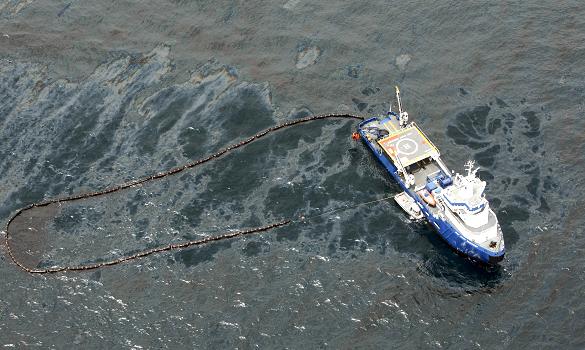
An oil slick covering 400sq miles is threatening a slow-motion catastrophe for the Gulf of Mexico’s delicate marine life, with 42,000 gallons (160,000 litres) a day now gushing from an uncapped well after a rig explosion.
Two days after declaring that there was no leak and that oil on the surface was residue from on board the Deepwater Horizon drilling platform that burst into a fireball on Tuesday, officials revealed that the slick was coming from the seabed and was now 25 times the size it was on Friday.
“It’s 1,000 barrels [a day] emanating from 5,000ft below the surface,” said Rear-Admiral Mary Landry, of the US Coast Guard, who is overseeing the emergency response. “Absolutely, this is a very serious oil spill.”
BP, which leased the rig, said last week that it was doing everything in its power to contain the spill and resolve the situation “as rapidly, safely and effectively as possible”, using underwater robots, 700 personnel, five aircraft, 32 vessels, and nearly 200 miles of floating booms.
One third of the global supply of oil dispersant is ready to be deployed.
Steve Benz, president of the Marine Spill Response Corporation, said yesterday: “At BP’s request, we are mounting the single largest response effort in MSRC’s 20-year history. We are confident in our ability to tackle this.”
Surface operations were at a halt yesterday because of stormy conditions with waves up to 10ft (3m) high.
“Right now we don’t have anyone on scene actively engaged due to the weather,” said Petty Officer Connie Terrell, of the coast guard.
The world’s worst oil spill was in 1989 when the Exxon Valdez tanker ran aground off Alaska, shedding 10.8 million gallons in a disaster from which local wildlife has still not recovered. The new leak would take 261 days to reach the same level, but a catastrophe is a real prospect if attempts to close off the broken pipes using robotic submarines fail.
BP will move another rig, known as DD3, into the area today, ready to start drilling a relief well that would ultimately stop the leak by injecting a specialised heavy fluid, but experts acknowledge that such an operation could take months to complete.
The slick is at present 50 miles off the coast of Louisiana, potentially threatening fragile coastal wetlands, fisheries, shrimp nurseries and other marine life such as sea turtles.
The area where the Deepwater Horizon previously stood is also a feeding ground for a pod of sperm whales, an endangered species, the National Oceanic and Atmospheric Administration revealed.
Florida, Mississippi, Alabama and Texas have been warned of the threat of the slick coming ashore.
Tuesday’s explosion occurred when pressure surged up the pipe connecting the Macondo well on the seabed to the drilling platform. Eleven workers are feared to have died but 115 others escaped in lifeboats.
The rig is now on the ocean floor 1,500ft from the well. The pipe that ran between them was severed, though a kink is keeping the oil from spilling as rapidly as it might.
The spill comes at a sensitive time, with President Obama moving last month to allow oil drilling closer to shore.
Senator Bill Nelson, of Florida, said: “This tragedy off the coast of Louisiana shows we need to be asking a lot more tough questions of Big Oil.”
April 26, 2010
Source: The Times